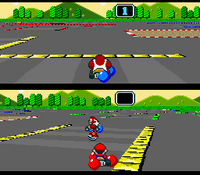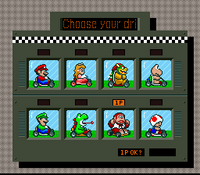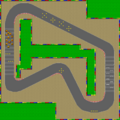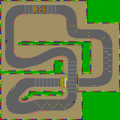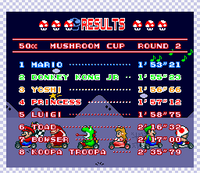Super Mario Kart
Template:Redirectshere Template:Infobox Super Mario Kart is a racing game for the Super Nintendo Entertainment System and the first game of the Mario Kart series, as well as the game that sets precedents to kart racing games. It was first released in 1992 and re-released in 1996 as a Player's Choice title. It was re-released on the Wii's Virtual Console in Japan on June 9, 2009, North America on November 23, 2009, and in Europe and Australia on April 2, 2010. Super Mario Kart was re-released again on the Wii U's Virtual Console in Japan on June 19, 2013, Europe on March 27, 2014, Australia on March 28, 2014, and in North America on August 6, 2014. Part of the game is heavily based on another successful game, Super Mario World.
Modes of play
Mario GP
The Mario GP is the main mode for Super Mario Kart. Here, players can race against seven (six in two-player mode) other CPU-controlled opponents in a five-course cup. The four best drivers will receive Driver Points for placing in the top four: first place gives the player nine points, second gets six, three points for third and only one for fourth, while fifth and below get zero points. If players get fifth or below, they can try again using one of three limited lives. If they get it four times, the mode is over. A single extra life can be earned by placing in the same position three times. The maximum score in a GP cup is forty-five, obtained by winning five times. The three best drivers will move on to the award ceremony where they can receive their trophies. Third place gives the player a bronze trophy, second gives them silver and gold for the winner (the player can watch the ceremony only when they place first: however, a protoype version has animations for second and third). Each race is five laps long. If players beat all of the cups on the class mode set to 150cc, the Message "Excellent driving, you are now a Super Mario Kart expert" pops up, thus officially telling players they have completed the game. If the player wants a better challenge, they have to hold and
at the character selection screen: their character will be permanently small, as under effect of a Lightning or a Poison Mushroom, until the player presses the buttons again. They will be slower in that state.
Vs. Mode
This mode is two-player only: the players can race each other like if they were in a GP, only that CPU racers do not appear, they can freely choose the track where to race in. Black objects slide around the courses as well, and coming in contact with one will result in the kart spinning out and the object disappearing as if it were a Green Shell. The game keeps track of wins and losses of each player.
Time Trial
This one-player mode have the player to race through five laps of the selected track the fastest they can without items. The five faster times are recorded, as well as the fastest lap and the characters used, for each track.
Battle
Another two-player mode, it is completely different from a normal race and adds some variety to the game. For this mode, there are four square-shaped tracks that are the only selectable. The player's goal is using the items to pop the opponent's balloons. Each player has three balloons that can't be recovered in any way. The first to pop all the opponent's balloons wins.
Button controls
SNES
- Accelerate, Rocket Start
- Use items, stop Item Roulette
- Pause/Select
- Switch view
 - Change option during the Menus/Steer
- Change option during the Menus/Steer- Switch view
- Brake
/
- Drift
Wii
 - Accelerate, Rocket Start
- Accelerate, Rocket Start - Use items, stop Item Roulette
- Use items, stop Item Roulette- - Pause/Select
- - Switch view
 - Switch view
- Switch view - Brake
- Brake /
/  - Drift
- Drift
Wii U
 - Accelerate, Rocket Start
- Accelerate, Rocket Start - Use items, stop Item Roulette
- Use items, stop Item Roulette - Pause/Select
- Pause/Select - Switch view
- Switch view- / - Change option during the Menus/Steer
Characters
The game features eight playable characters from the Mario series, such as Mario, Luigi, Yoshi and Bowser. However, some other characters from the series acts as obstacles in the game's tracks, like Thwomps, Monty Moles, Piranha Plants and Cheep Cheeps. Boos don't act as enemies, but both as item and as part of the Ghost Valley tracks' background.
As stated in the game's manual, Lakitu is the owner of all the racetracks, thus overseeing all races. It will appear on the track to start the race, to warn the player they are going backwards, and when they fall off the edge of the track or go out of bounds. If the latter happens, Lakitu will transport the racer back to track at the price of two Coins.
Drivers
Super Mario Kart has eight available drivers, divided into statistically identical pairs of two. These four categories have no official name, but are referred in the manual as different classes. Later Mario Kart titles categorize characters into weight classes to organize their stats. The stats presented here are derived and inferred from the manual.
|
|
|
|
Non-Playable
Courses
Race courses
The game has 20 race courses and 4 battle courses, the first being divided in four cups. Aside from Rainbow Road, all of the courses are numbered.
| Name | Terrain and obstacles | |
|---|---|---|
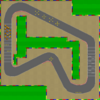
|
Mario Circuit | Terrain: Sandy
Obstacles: Oil Slick - The player spins out upon contact (similar to a Banana). |
| File:SNES Donut Plains 1.png | Donut Plains | Terrain: Grassy
Obstacles: Monty Moles - They jump out of holes. If someone runs into one, they get caught on the kart and slow down racers until knocked off. |
| File:SNES Ghost Valley 1.png | Ghost Valley | Terrain: Wooden
Obstacles: Falling walls - Once hit, it falls, leaving the abyss below open. |
| File:SNES Bowser Castle 1.png | Bowser Castle | Terrain: Stone
Obstacles: Thwomp - They smash down on the floor. Anyone caught under them at that moment will be flattened and unable to move, costing time. |
| File:SNES Choco Island 1.png | Choco Island | Terrain: Chocolate
Obstacles: Piranha Plants - The player again spins out if they touch these. |
| File:SNES Koopa Beach 1.png | Koopa Beach | Terrain: Sand/water
Obstacles: Cheep Cheeps - The player spins out when touching these. |
| File:SNES Vanilla Lake 1.png | Vanilla Lake | Terrain: Icy
Obstacles: The terrain is icy, thus the player has less traction. |
| File:SNES Rainbow Road.png | Rainbow Road | Terrain: Rainbow tiles
Obstacles: There are not any walls, so the player can fall from anywhere. |
- Mushroom Cup
- SNES Donut Plains 1.png
- SNES Ghost Valley 1.png
- SNES Bowser Castle 1.png
- Flower Cup
- SNES Choco Island 1.png
- SNES Ghost Valley 2.png
- SNES Donut Plains 2.png
- SNES Bowser Castle 2 map.png
- SNES Mario Circuit 3 map.png
- Star Cup
- SNES Koopa Beach 1.png
- SNES Choco Island 2.png
- SNES Vanilla Lake 1.png
- SNES Bowser Castle 3 map.png
- SNES Mario Circuit 4.png
- Special Cup
- SNES Donut Plains 3.png
- SNES Koopa Beach 2.png
- SNES Ghost Valley 3.png
- SNES Vanilla Lake 2.png
- SNES Rainbow Road.png
Battle courses
- BC1SNES.png
- BC2SNES.png
- BC3SNES.png
- BC4SNES.png
Items
Items are obtained through ? Panels, scattred around the track. When the player passes over one, it will turn red (used) and not return orange (though in Battle Mode they did). Once a racer passes over one, with a few exceptions, they will receive an item in their box from the following:
| Item | Description | Notes |
|---|---|---|
Banana Peel |
When a kart hits a Banana Peel, it will spin out. | Can be thrown backward and forward. Also used by Donkey Kong Jr. if he is CPU-controlled. |
Green Shell |
The Green Shell will send an enemy into a spin if they are hit. Green Shell's can bounce off barriers. Throwing it backwards will cause it to remain stationary. | Can be thrown backward and forward. Used by Koopa if CPU-controlled, but they will behave similar to Banana Peels even when thrown forward, and remain stationary. |
Red Shell |
The Red Shell acts similarly to a Green Shell, but homes in on the target instead. It will not bounce off walls, however. | Can only be thrown forward. |
Feather |
A Feather allows the user to perform a high jump, high enough to make create shortcuts normally impossible and to sail over obstacles and other racers. | This is the only Mario Kart game where it appears as item. |
Mushroom |
A Mushroom is more common item than a Feather or a Star, and allows the user to boost. It can either be used to slam an opponent or drive over hazards such as sand and grass without losing speed. | |
Star |
The Star provides two benefits, allowing the user to receive a small speed boost and to become invulnerable to everything. Contact with other racers will cause them to spin out. | Used also by Mario and Luigi if they are CPU-controlled. They will not receive a speed boost, however, and the effect does not last as long. |
| File:SMKGhost.png Ghost |
The Ghost turns the user invisible and steals an opponent's item. | Only appears in Battle Mode and Match Race. |
| File:SMKCoin.png File:SMKCoin v2.png Coin |
The Coin adds to coins to the total coin count, increasing the users overall top speed. | Doesn't appear in Battle Mode. |
Lightning |
The Lightning Bolt shrinks all the racers except for the user, making them slower and vulnerable to being squashed by normal sized racers. The effect will wear after a brief period of time. | Doesn't appear in Battle Mode. |
| File:SMKEgg.png Egg |
Works similar to a Banana Peel. | Usable only by Yoshi if he is CPU-controlled. |
 Fireball |
Similar to a Banana Peel, but oscillates from left to right on the spot, making them harder to pass safely. | Usable only by Bowser if he is CPU-controlled. |
 Poison Mushroom |
A stationary item. If one is run into, the victim shrinks as if hit by a Lightning Bolt. The racer who is already shrunk and runs into it returns to normal size. | Usable only by Peach and Toad if they are CPU-controlled. |
Rivals
Super Mario Kart has a different rival system from the rest of the series; the rivals contain one very fast driver, one fast driver, one medium driver, one slow driver and three very slow drivers. It is notable that when one of the three slower drivers gets hit, that kart will keep its place, while when one of the faster cars gets shot, it will usually resume its previous place very quickly unless unable to catch up fast enough before the race ends. For this reason, the drivers (except the human racer) will (if unaffected) always finish in the exact same order. Also, if the player tries to hit an opponent, the opponent jumps over the item a majority of the time.
The rivals for each driver are always the same, the list will be in the order the line up for the first race. It is possible to change the order if the rivals can't recover their place at the end (Eg. If someone is playing as Luigi and Yoshi finishes last, Yoshi will then become one of the three slower drivers while everybody takes the next position up). It happens mostly on 100cc and 150cc.
The rivals are determined by the current points standing, meaning that if Yoshi was still only second to the player, he will boost back to first position from the start.
| Character | Rival Order | ||||||
|---|---|---|---|---|---|---|---|
| Very Fast | Fast | Medium | Slow | Very Slow | |||
| Mario | Donkey Kong Jr. | Peach | Yoshi | Luigi | Toad | Bowser | Koopa Troopa |
| Luigi | Yoshi | Mario | Bowser | Koopa Troopa | Peach | Donkey Kong Jr. | Toad |
| Princess | Bowser | Toad | Mario | Donkey Kong Jr. | Luigi | Yoshi | Koopa Troopa |
| Yoshi | Koopa Troopa | Donkey Kong Jr. | Peach | Bowser | Mario | Toad | Luigi |
| Bowser | Mario | Luigi | Peach | Yoshi | Donkey Kong Jr. | Toad | Koopa Troopa |
| Donkey Kong Jr. | Toad | Bowser | Koopa Troopa | Luigi | Peach | Mario | Yoshi |
| Koopa Troopa | Luigi | Yoshi | Peach | Mario | Bowser | Donkey Kong Jr. | Toad |
| Toad | Peach | Donkey Kong Jr. | Mario | Yoshi | Luigi | Koopa Troopa | Bowser |
Development
Super Mario Kart was born out of the idea of making a two-player racing game following F-Zero, which was exclusively single-player.[1] The prototype initially only featured a generic "guy in overalls". The decision to include Mario characters and concepts was made three to four months in development, when the developers added Mario driving one of the karts because they were curious about how the game would look, and decided that it looked better.[1] The battle mode was implemented because the developers thought it would be a good idea to include a form of one-on-one battles that didn't involving competing for ranks during the races.[1]
Pre-release and unused content
- Main article: List of Super Mario Kart pre-release and unused content
In addition to the above, a prototype cartridge of the game features several differences, such as the presence of animations on the podium screen when the player ranks 2nd or 3rd place, a music track for Vanilla Lake 1 that does not appear in the final build and a different Battle Course 3 set in Choco Island.
Reception
Super Mario Kart met with very favorable reviews. The game was placed 32nd in the 100th issue of Nintendo Power's "100 best Nintendo games of all time" in 1997.[2]. In the book, Guinness World Records: Gamer's Edition for 2009, Super Mario Kart was placed as the #1 best console game. The game was placed 33rd in the 200th issue of GameInformer's "Top 200 Games of all Time" in December 2009. The game was awarded the Most Critically Acclaimed Mario Kart Game by Guinness Book of World Records Gamer's Edition 2009 - 2014.
Super Mario Kart is the 3rd best selling game for the Super Nintendo Entertainment System, selling 8.76 million copies worldwide as of December 31, 2009.
Staff
- Main article: List of Super Mario Kart staff
References to other games
- Super Mario Bros.: The Lost Levels: The computer-controlled Toad and Peach are able to throw Poison Mushrooms, which are not usable by the player.
- Super Mario World: Several sound effects from this game are reused, for example, the music in the Bowser's Castle levels is very similar from the final boss in this game. Most of the races take place on Dinosaur Land. Also, sprites such as the Lakitu bear a resemblance to their Super Mario World sprite.
References in later games
- Mario Kart: Super Circuit: All twenty of the courses appeared in this game, but all of their track hazards have been removed, Item Boxes are at different places than where ? Panels laid and some tracks changed a little. The music for all tracks is redone for the Game Boy Advance.
- Mario Kart DS: Mario Circuit 1, Donut Plains 1, Koopa Beach 2, and Choco Island 2 all return to this game.
- Super Smash Bros. Brawl: The music from Mario Circuit is remixed in the stage with the same name.
- Mario Kart Wii: Ghost Valley 2 and Mario Circuit 3 return as retro tracks and Battle Course 4 returns as a retro battle stage.
- Mario Kart 7: Mario Circuit 2 and Rainbow Road return as retro tracks. Also, the rival system returned in this game.
- Super Mario 3D World: Mount Must Dash is based on Mario Circuit from this game. Also, the music from Mario Circuit is remixed.
- Mario Kart 8: Donut Plains 3 returns as a retro track. Also the Coin item returns with the same function as it did in this game. The Pipe Frame is similar to the karts in this game. Part of the main theme is an orchestrated version of the main theme of Super Mario Kart. The design of N64 Rainbow Road and Rainbow Road for this game are very similar to Rainbow Road, which also appears in this game in the DLC cup, Triforce Cup.
Gallery
- MKMario.PNG
- BattleSMK.jpg
Mario and Bowser
- LakituSMK.png
- SMK Logo.png
The game's logo.
Media
- Main article: List of media from Super Mario Kart
Glitches
- Main article: List of glitches in Super Mario Kart
Names in other languages
Trivia
This trivia section is overly long. Please relocate any relevant information into appropriate sections and articles.
- In every version of Super Mario Kart, every character has a winning animation that involves a bottle of champagne. In the Japanese version, Bowser and Peach/Toadstool drink champagne in their said animations, which goes against Nintendo of America's policy on the depiction of alcohol, as it was considered inappropriate for younger children. Instead, Peach just tosses and catches the bottle and Bowser just moves his arms up and down while holding the bottle. (Which is mostly the same animation but with the bottle repositioned.)
- This is the only game in the Mario Kart series to have five courses per cup, as opposed to four in later games (not counting All-Cup Tour in Mario Kart: Double Dash!!).
- This is also the only game in the Mario Kart series where Wario, Donkey Kong, the Spiny Shell, the Triple Mushrooms, and the Triple Red and Green Shells do not appear. They are introduced in the next installment of the series, Mario Kart 64.
- Super Mario Kart is the only Mario Kart title without the functionality for four player play.
- The North American commercial uses the same cutscenes as the Japanese commercial, but the only difference is that the North American commercial begins with the racers racing on the I and O of the logo and ends with the game's box racing on Donut Plains until it comes to a complete stop and being replaced by the SNES logo.
- Also, the commercials show the bridge on Donut Plains collapsing as Donkey Kong Jr. spins out after being pelted with a Banana thrown by Peach, yet in the game bridges are not collapsible. However, Peach tosses the Banana with her left hand, but in the next shot when the scene cuts from Koopa Beach to Donut Plains, her right arm is extended instead until she has both hands back on the steering wheel. Additionally, the trees did not appear in any Donut Plains course until Mario Kart 8's rendition of Donut Plains 3.
- If the player touches a Poison Mushroom set by the CPU-controlled Peach or Toad, the power-down SFX plays. Ironically, if a CPU touches it, the SFX of a CPU getting hit by any items plays instead.
- Yoshi, Bowser, and Donkey Kong Jr. are the only drivers in this game to have their own taunts when surpassing other racers regardless if they are being used by the player or CPU. The others do not have their own taunts and instead the standard beep is heard when surpassing other racers but can only be heard when used by the player.
References
- ^ a b c Iwata Asks: Mario Kart Wii (accessed March 22 2012)
- ^ http://www.gamekult.com/communaute/forum/voirmessage.html?foid=13000909, retrieved 6/4/2009
Template:MK Players Template:Mariogames
